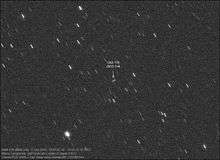Satellite Data System

The Satellite Data System (SDS) is a system of United States military communications satellites. At least three generations have been used: SDS-1 from 1976 to 1987; SDS-2 from 1989 to 1996; SDS-3 from 1998 to the present. It is believed that these satellites were known by the code name Quasar.[1] The first generation were named simply 'SDS', the second generation were named 'Quasar' and the third generation each carried their own designation names.[2]
Orbital characteristics
SDS satellites have a highly elliptical orbit, going from about 300 kilometers at perigee to roughly 39,000 km at apogee in order to allow communications with polar stations that cannot contact geosynchronous satellites. The high apogee meant that the polar regions were visible for long amounts of time, and only two satellites were required in order to achieve constant communications ability. In addition, two geostationary satellites appear to be part of the system. The SDS satellites were constructed by Hughes Aircraft.
Mission
The primary purpose of the SDS satellites is to relay imagery from low-flying reconnaissance satellites, notably the Keyhole optic reconnaissance and Lacrosse/Onyx radar reconnaissance satellites to ground stations in the United States.[3]
SDS-1

Each SDS-1 satellite had 12 channels available for ultra-high frequency communication. They were cylindrical in shape, roughly 25 feet (7.6 m) long. 980 watts of electrical power were available from solar panels and batteries.
The SDS-1 had a mass of 1385 pounds (630 kilograms) and was launched on Titan-3B rockets. The SDS-1 satellites had similar orbits to the Air Force's Jumpseat ELINT satellites.[4]
SDS-2
The SDS-2 is significantly more massive at 5150 pounds (2335 kg), with three separate communication dishes, including one for a K band downlink. Two dishes are 15 feet (4.5 meters) in diameter, while the third is 6.6 feet (2 m) in diameter. The solar arrays generate 1238 watts of power. It is believed that the Space Shuttle has been used to launch several satellites, possibly on missions STS-28, STS-38, and STS-53. Other launches have used the Titan-4 rocket.
SDS-3
Satellites
| Name | COSPAR ID[5] SATCAT № |
Launch date | Launch vehicle | Launch site | NROL designation | Perigee | Apogee | Inclination | Remarks |
|---|---|---|---|---|---|---|---|---|---|
| OPS 7837 | 1976-050A 08871 |
1976-06-02 | Titan III(34)B | VAFB SLC-4W | N/A | ||||
| OPS 7940 | 1976-080A 09270 |
1976-08-06 | Titan III(34)B | VAFB SLC-4W | |||||
| OPS 7310 | 1978-075A 10993 |
1978-08-05 | Titan III(34)B | VAFB SLC-4W | |||||
| OPS 5805 | 1980-100A 12093 |
1980-12-13 | Titan III(34)B | VAFB SLC-4W | |||||
| USA-4 | 1984-091A 15226 |
1984-08-28 | Titan III(34)B | VAFB SLC-4W | |||||
| USA-9 | 195-014A 15546 |
1985-02-08 | Titan III(34)B | VAFB SLC-4W | |||||
| USA-21 | 1987-015A 17506 |
1987-02-15 | Titan III(34)B | VAFB SLC-4W | |||||
| USA-40 | 1989-061B 20167 |
1989-06-02 | Space Shuttle Columbia STS-28/Orbus-21S |
KSC LC-39B | N/A | ||||
| USA-67 | 1990-097B 20963 |
1990-11-15 | Space Shuttle Atlantis STS-38/Orbus-21S |
KSC LC-39A | Geosynchronous satellite, deployed along with Prowler and initially misidentified as a Magnum SIGINT spacecraft | ||||
| USA-89 | 1992-086B 22518 |
1992-12-02 | Space Shuttle Discovery STS-53/Orbus-21S |
KSC LC-39A | |||||
| USA-125 | 1996-038A 23945 |
1996-07-03 | Titan IV(405)A | CCAFS LC-40 | |||||
| USA-137 | 1998-005A 25148 |
1998-01-29 | Atlas IIA | CCAFS SLC-36A | NROL-5 | Capricorn | |||
| USA-155 | 2000-080A 26635 |
2000-12-06 | Atlas IIAS | CCAFS SLC-36A | NROL-10 | Great Bear, geosynchronous satellite at 10° West | |||
| USA-162 | 2001-046A 26948 |
2001-10-11 | Atlas IIAS | CCAFS SLC-36B | NROL-12 | Aquilla, geosynchronous satellite at 144° West | |||
| USA-179 | 2004-034A 28384 |
2004-08-31 | Atlas IIAS | CCAFS SLC-36A | NROL-1 | Nemesis, final Atlas II launch | |||
| USA-198 | 2007-060A 32378 |
2007-12-10 | Atlas V 401 | CCAFS SLC-41 | NROL-24 | Scorpius | |||
| USA-227 | 2011-011A 37377 |
2011-03-11 | Delta IV-M+(4,2) | CCAFS SLC-37B | NROL-27 | Gryphon, geosynchronous satellite at 10° West, replaced USA-155 | |||
| USA-236 | 2012-033A 38466 |
2012-06-20 | Atlas V 401 | CCAFS SLC-41 | NROL-38 | Drake, geosynchronous satellite at 144° West, replacement for USA-162 | |||
| USA-252 | 2014-027A 39751 |
2014-05-22 | Atlas V 401 | CCAFS SLC-41 | NROL-33 | Geosynchronous satellite | |||
| USA-269 | 2016-047A 41724 |
2016-07-28 | Atlas V 421 | CCAFS SLC-41 | NROL-61 | Spike, Geosynchronous orbit, might be a new generation[6] | |||
References
- ↑ Jonathan's Space Report: NRO Satellite Names
- ↑ Jonathan's Space Report: Satellite Catalogue
- ↑ Richelson J.T., 2001: The Wizards of Langley. Inside the CIA's Directorate of Science and Technology. Westview press, Boulder
- ↑ National Reconnaissance Office: "NRO Brochure circa 1997"
- ↑ Jonathan's Space Report: List of satellite launches
- ↑ "NROL-61 satellite launched Thursday spotted in space by sky-watchers". Spaceflight Now. July 30, 2016.
- Vick, Berman, Lindborg, Fellow (March 19, 1997). SDS-1 Military Communications Satellite. Federation of American Scientists. Accessed April 24, 2004.
- Vick, Berman, Lindborg, Fellow, Pike, Aftergood (March 19, 1997). SDS-2 Military Communications Satellite. Federation of American Scientists. Accessed April 24, 2004.